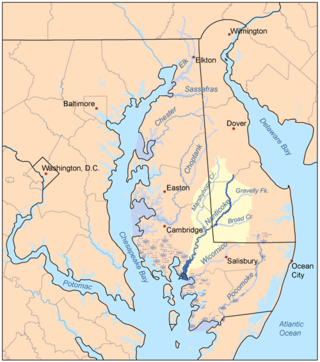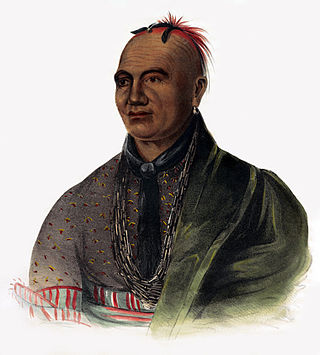
The Powhatan people (;) are Native Americans who belong to member tribes of the Powhatan Confederacy, or Tsenacommacah. They are Algonquian peoples whose historic territories were in eastern Virginia.

The Algonquians are one of the most populous and widespread North American native language groups. They historically were prominent along the Atlantic Coast and in the interior regions along Saint Lawrence River and around the Great Lakes. This grouping consists of the peoples who speak Algonquian languages.

The Nanticoke people are a Native American Algonquian people, whose traditional homelands are in Chesapeake Bay and Delaware. Today they live in the Northeastern United States and Canada, especially Delaware; in Ontario; and in Oklahoma.

Indigenous peoples of the Northeastern Woodlands include Native American tribes and First Nation bands residing in or originating from a cultural area encompassing the northeastern and Midwest United States and southeastern Canada. It is part of a broader grouping known as the Eastern Woodlands. The Northeastern Woodlands is divided into three major areas: the Coastal, Saint Lawrence Lowlands, and Great Lakes-Riverine zones.

The Eastern Algonquian languages constitute a subgroup of the Algonquian languages. Prior to European contact, Eastern Algonquian consisted of at least 17 languages, whose speakers collectively occupied the Atlantic coast of North America and adjacent inland areas, from what are now the Maritimes of Canada to North Carolina. The available information about individual languages varies widely. Some are known only from one or two documents containing words and phrases collected by missionaries, explorers or settlers, and some documents contain fragmentary evidence about more than one language or dialect. Many of the Eastern Algonquian languages were greatly affected by colonization and dispossession. Miꞌkmaq and Malecite-Passamaquoddy have appreciable numbers of speakers, but Western Abenaki and Lenape (Delaware) are each reported to have fewer than 10 speakers after 2000.
Turkey Tayac, legally Philip Sheridan Proctor (1895–1978), was a Piscataway leader and herbal medicine practitioner; he was notable in Native American activism for tribal and cultural revival in the 20th century. He had some knowledge of the Piscataway language and was consulted by the Algonquian linguist, Ives Goddard, as well as Julian Granberry.

The Piscataway Indian Nation, also called Piscatawa, is a state-recognized tribe in Maryland that is descended from the historic Piscataway people. At the time of European encounter, the Piscataway was one of the most populous and powerful Native polities of the Chesapeake Bay region, with a territory on the north side of the Potomac River. By the early seventeenth century, the Piscataway had come to exercise hegemony over other Algonquian-speaking Native American groups on the north bank of the river. The Piscataway nation declined dramatically before the nineteenth century, under the influence of colonization, infectious disease, and intertribal and colonial warfare.

The Piscataway or Piscatawa, are Native Americans. They spoke Algonquian Piscataway, a dialect of Nanticoke. One of their neighboring tribes, with whom they merged after a massive decline of population following two centuries of interactions with European settlers, called them the Conoy.
The Nanticoke Lenni-Lenape Tribal Nation are a tribal confederation of Nanticoke of the Delmarva Peninsula and the Lenape of southern New Jersey and northern Delaware. They are recognized by the state of New Jersey, having reorganized and maintained elected governments since the 1970s. They are not a federally recognized tribe.

The Yaocomico, also spelled Yaocomaco, were an Algonquian-speaking Native American group who lived along the north bank of the Potomac River near its confluence with the Chesapeake Bay in the 17th century. They were related to the Piscataway, the dominant nation north of the Potomac.

The Doeg were a Native American people who lived in Virginia. They spoke an Algonquian language and may have been a branch of the Nanticoke tribe, historically based on the Eastern Shore of Maryland. The Nanticoke considered the Algonquian Lenape as "grandfathers". The Doeg are known for a raid in July 1675 that contributed to colonists' uprising in Bacon's Rebellion.
Nanticoke is an Algonquian language formerly spoken in Delaware and Maryland, United States. The same language was spoken by several neighboring tribes, including the Nanticoke, which constituted the paramount chiefdom; the Choptank, the Assateague, and probably also the Piscataway and the Doeg.
The Nacotchtank were an indigenous Algonquian people who lived in the area of what is now Washington, D.C., during the 17th century. The Nacotchtank village was within the modern borders of the District of Columbia along the intersection of the Potomac and the Anacostia river.
The Patuxent or Pawtuxent were one of the Native American tribes living along the western shore of the Chesapeake Bay. They spoke an Algonquian language and were loosely dominated by the Piscataway.
Mary Kittamaquund, daughter of the Piscataway chieftain Kittamaquund, helped establish peaceful relations between English immigrants to the Maryland and Virginia Colonies and their native peoples.

Around 1622, the Piscataway tribe, which led the Conoy Federation, built a town they soon called Kittamaqundi on Piscataway Creek near the modern day town of Piscataway, Prince George's County, Maryland. When English first visited the town, in 1634, they learned it was named after the relatively new Tayac (Emperor) Kittamaquund, who had assumed power the previous year after killing his brother Wannas.
The history of Native Americans in Baltimore and what is now Baltimore dates back at least 12,000 years. As of 2014, Baltimore is home to a small Native American population, centered in East Baltimore. The majority of Native Americans now living in Baltimore belong to the Lumbee, Piscataway, and Cherokee tribes. The Piscataway people live in Southern Maryland and are recognized by the state of Maryland. The Lumbee and Cherokee are Indigenous to North Carolina and neighboring states of the Southeastern United States. Many of the Lumbee and Cherokee migrated to Baltimore during the mid-20th century along with other migrants from the Southern United States, such as African-Americans and white Appalachians. The Lumbee are state recognized in North Carolina as the Lumbee Tribe of North Carolina, but have no state recognition in Maryland. The Eastern Band of Cherokee Indians in North Carolina are a federally recognized tribe. There are three state recognized tribes in Maryland; the Piscataway-Conoy Tribe of Maryland, the Piscataway Indian Nation and Tayac Territory, and the Accohannock Indian Tribe. Maryland has no federally recognized tribes.

The Indigenous peoples of Maryland are the tribes who historically and currently live in the land that is now the State of Maryland in the United States of America. These tribes belong to the Northeastern Woodlands, a cultural region.
The Piscataway Conoy Tribe of Maryland is a Native American tribe recognized by the state of Maryland. They are a part of the Piscataway people.











